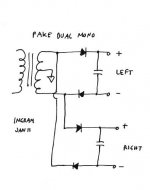Member
Joined 2009
Paid Member
Are there significant benefits using a dual mono supply ?
If I have only a single transformer with single centre tapped secondary it would seem the only option is a single power supply for both channels based on a bridge rectifier and a filter section.
What if I used two half-wave rectifiers, one for each channel. Only one channel is 'communicating' with the transformer at any one time since their filter capacitors are being charged at different times.
Each rectifier 'sees' half the load - i.e. only one channel so even though the charge pulses are now half as often the ripple voltage is the same as it would be if there were a bridge rectifier feeding both channels together.
Thoughts ?
If I have only a single transformer with single centre tapped secondary it would seem the only option is a single power supply for both channels based on a bridge rectifier and a filter section.
What if I used two half-wave rectifiers, one for each channel. Only one channel is 'communicating' with the transformer at any one time since their filter capacitors are being charged at different times.
Each rectifier 'sees' half the load - i.e. only one channel so even though the charge pulses are now half as often the ripple voltage is the same as it would be if there were a bridge rectifier feeding both channels together.
Thoughts ?
Attachments
Does not the power supply need the filter caps to be referenced to GND? Other than that, half wave is fine and dandy but you will have twice the charging current at half the frequency of the bridge and with larger ripple. After all, the load circuit sees as its power source the charged capacitors not so much the transformer. IMHO two seperate bridge rectifiers from the secondary and sets of filter caps (if bipolar supply is required) would be a better solution. If this is for a power amp circuit, half wave is not such a good idea.
- Status
- Not open for further replies.
